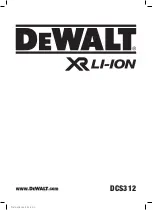
10
EASY 180
IMER INTERNATIONAL S.p.A.
of at least 6 mm². Cables used on construction sites must be
fitted with suitable external sheathing that is resistant to wear,
crushing and extreme weather conditions.
11. MACHINE START-UP
1 - Ensure that the tank contains sufficient cooling water.
2 - Ensure that the power circuit corresponds to the require-
ments specified in section 10 "Electrical Connection".
3 - Connect the machine to the power supply.
4 - Press the switch marked " I " and when the motor is running
press pushbutton " 0 ": ensure that cooling water is delivered
to the blade.
5 - Check that the direction of blade rotation is in the direction
of the arrow on the blade guard.
6 - If all is in order, proceed with cutting.
12. EMERGENCY STOP
In an emergency, turn the main switch off imme-
diately to stop blade rotation.
The motor is protected against automatic re-start
after interruptions due to power failure. To resume
operation, when power is re-connected press pushbutton
"I".
The machine is fitted with a fuse in the motor
winding which in the case of overload prevents short cir-
cuits by interrupting the circuit. In the event of the latter,
contact an electrician to replace the motor
.
13. USE
Leave sufficient space around the machine to
ensure safe operation.
-
Do not allow other persons to approach the machine during
cutting.
-
Never use the machine in fire-risk areas. Sparks can cause
fire or explosions.
-
Always ensure that the blade is free of any contact before
start-up; start cutting only when the operating speed is
reached.
Ensure that the blade guard is secured in posi-
tion.
Ensure that blade rotation corresponds to the
indications on the blade guard.
- Before starting work, fill the water tank (4). Top up during
operation whenever necessary: the plastic blade guard must
remain immersed in water. The tank must be filled nearly to
the rim.
Top up via outlet (6).
WARNING!!! For safety purposes the removal of
protective guards from the machine is strictly prohibited.
The machine is protected against overload by
means of a safety fuse. In the event of motor overload the
fuse blows and shuts down the motor.
WARNING!!! Always switch off the machine before
carrying out adjustments.
The cutting blades must NEVER be subject to
lateral pressure! In this case the blades may break and
project sharp fragments at high speed.
Do not cut excessively small workpieces. Take care during
operation that the entire surface of the workpiece remains in
contact with the work surface. To move medium sized tiles on
the machine, use the tile support provided.
Never overload the motor. Safe and optimal operation is
ensured with the blade at rated working speed. Never cut
materials other than tiles.
Observe all instructions for maintenance and replacement of
the cutting blade.
Do not use the machine if suffering from fatigue.
Before cutting, check that there is no damage in particular to
the cutting blade. Before use all damaged parts or guards
must be repaired or replaced. Movable parts, in particular
those covering the blade must be completely efficient and
move freely. Do not use the machine if the main switch is faulty.
Never lock or remove the blade guard. If the blade
guard is blocked, repair immediately.
13.1 Cutting with the parallel fence (Fig. 1)
The parallel fence (3) enables cutting parallel to an edge. To
adjust, slacken the knobs (7), set to the required distance
and secure in place by means of the knobs.
13.2 Bevel cuts (Fig. 1)
To make a bevel cut between 0° and 45°, slacken the knob
(5), adjust the bevel cut by raising the table (1) to the required
angle and retighten the knob (5).
As the cutting thickness increases, the blade is
subjected to greater stress to remove material. To avoid
overloading the motor, the operator should continually
check blade feed speed. The speed will also depend on
the characteristics of the material being cut (hardness,
toughness, etc.).
14. MAINTENANCE
WARNING!!! Always switch off the machine and
remove the plug from the power socket before carrying
out maintenance.
Always check that the protective guards are in
the correct position and are in perfect condition.
There is the continuous risk of inadvertent dam-
age to electric cables and therefore check regularly be-
fore using the machine.
Never leave the machine outside or on the ground; store in a
sheltered area disconnected from the power supply.
- Replace worn or faulty components with original spare parts.
All repairs must be carried out by suitably qualified technical
personnel to avoid the risk of serious accidents.
14.1 CLEANING ON WORK COMPLETION
- On completion of work, empty the tank and remove. Clean
thoroughly to remove all cutting residue.
Keep work surfaces clean. Residual dirt can impair cutting
precision.
14.2 BLADE CHECKS AND REPLACEMENT
If the cutting blade is scratched or deformed, replace
immediately.
To replace worn blades, proceed as follows:
a. Remove the plug from the power socket;
b. Remove the tank (4, Fig. 1);
c. Loosen the front blade guard fixing screws;
d. Loosen the first blade locknut by means of two 19 mm
wrenches;
e. Loosen the second locknut by means of a 19 mm wrench
and using an 8 mm wrench to hold the shaft in position;
f. Remove the counterflange (3, Fig. 2), withdraw the blade
and fit the new version on the flange (1, Fig. 2). Note the
direction of rotation as indicated on the blade. Refit the
counterflange (3, Fig. 2);
g. Tighten the first blade fixing nut (6, Fig. 2) by means of the
two wrenches (19 mm and 8 mm), and tighten the locknut by
FIG.2
GB








































